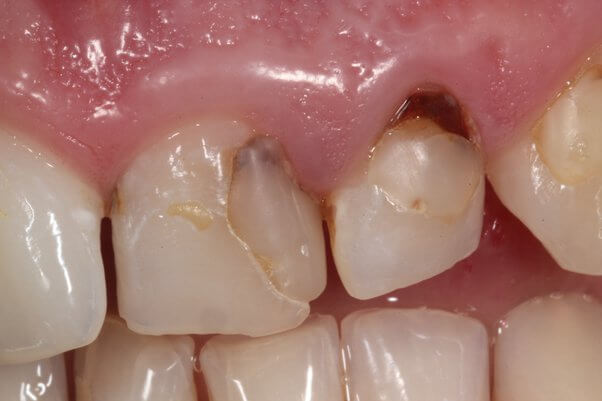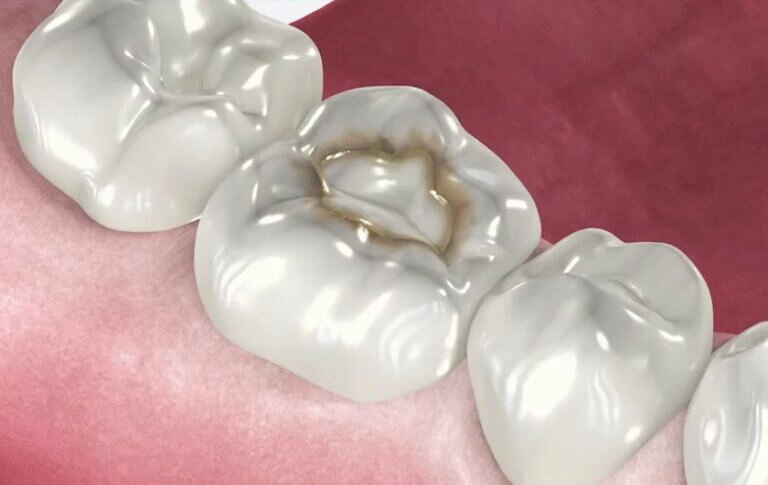Discolored Filling

What Is A Discolored Filling?
A discolored filling is a dental restoration that has changed color over time, often becoming darker or yellowed compared to the surrounding tooth enamel. Fillings are typically made from composite resin, a tooth-colored material designed to repair cavities and restore teeth to their natural look. However, exposure to certain foods, beverages, and lifestyle habits can cause fillings to stain or age, making them stand out against the rest of your smile.
While discolored fillings are often a cosmetic concern, they can also affect your oral health if left untreated. Before you contact a Toronto dentist to examine a Discolored Filling, there are some things you should know as a patient:
- Why Do Fillings Become Discolored?
- Signs And Symptoms Of Discolored Fillings
- Treatment Options For Discolored Fillings
- Managing Discolored Fillings Until You Can See The Dentist
- Frequently Asked Questions About Discolored Fillings
If you have questions about Discolored Fillings or other dental problems, please contact us for more information.
Why Do Fillings Become Discolored?
Understanding why fillings become discolored can help in preventing or managing the issue. Common causes of discolored fillings include:
- Staining from Food and Beverages: Frequent consumption of coffee, tea, red wine, and dark-colored fruits and vegetables can cause staining on fillings, especially if they are composite resins that tend to absorb pigments over time.
- Aging of Filling Material: Composite fillings can degrade and discolor as they age. This process can happen even faster if the filling is older and exposed to saliva, moisture, and daily wear.
- Wear and Tear: Fillings experience daily forces from chewing, grinding, or clenching, which can cause them to chip, crack, or wear down, leading to discoloration and other potential issues.
- Inadequate Oral Hygiene: Failure to brush and floss regularly can lead to plaque and bacteria buildup around the filling edges, creating discoloration and possibly even secondary cavities.
- Underlying Tooth Decay: New decay beneath a filling can cause discoloration and even weaken the filling’s bond to the tooth. Bacteria may penetrate the filling, leading to cavities and dark spots.
- Smoking or Tobacco Use: Tobacco products are known to stain teeth and fillings, leaving them with a yellow or brownish tint over time.
By understanding the causes of discolored fillings, you can take steps to prevent them and keep your teeth looking healthy and vibrant. If you have further questions about what causes Discolored Fillings, please contact us.
Signs And Symptoms Of Discolored Fillings
If you think your fillings may be discolored, look for the following signs:
- Yellowing or Dark Spots: The filling may appear darker or have a yellowish tint compared to your natural enamel.
- Rough or Uneven Surface: Aged fillings may develop a rough, uneven surface that can trap plaque and bacteria, accelerating discoloration.
- Increased Sensitivity or Pain: Worn or damaged fillings may expose the sensitive dentin layer beneath, causing discomfort, especially when eating hot or cold foods.
If you notice any of these symptoms, it’s best to consult your dentist. Early intervention can prevent further decay or damage to the tooth. If you have further questions about the signs and symptoms of Discolored Fillings, please contact us.

Treatment Options For Discolored Fillings
Discolored fillings can be treated in several ways depending on the level of damage or discoloration:
Replacing the Filling: The most common solution for discolored fillings is replacement. Modern dental materials are more resistant to discoloration, providing a long-lasting and aesthetically pleasing result.
Professional Teeth Whitening: If the discoloration affects the natural tooth surrounding the filling rather than the filling itself, teeth whitening treatments can lighten the shade and improve the overall look of your smile.
Porcelain Veneers or Dental Crowns: For teeth with extensive fillings or severe discoloration, a veneer or crown can cover the affected tooth entirely, restoring its appearance and reinforcing its structure.
Your dentist will assess the condition of your fillings and recommend the most suitable treatment for restoring your smile. If you have further questions about treatment options for Discolored Fillings, please contact us.
Managing Discolored Fillings Until You Can See The Dentist
If you notice a discolored filling but cannot visit the dentist immediately, consider these temporary measures to minimize discomfort and manage the appearance of the filling:
- Good Oral Care Routine: Brush and floss diligently, and consider using a water flosser to keep teeth and fillings clean.
- Try At-Home Whitening Kits: Products like Crest 3D Whitestrips may reduce surface stains; however, results may vary based on the filling material. Always follow product instructions closely.
- Avoid Smoking and Limit Stain-Causing Foods: Cutting back on tobacco and dark foods/beverages can help reduce further discoloration until your next dental appointment.
- Stay Hydrated: Drinking water throughout the day helps rinse away stain-causing particles and keep your mouth healthier overall.
While these strategies can help to manage discomfort associated with discolored fillings, it’s important to see your dentist as soon as possible to address the underlying issue and prevent further damage. If you have further questions about how to manage Discolored Fillings, please contact us.
Frequently Asked Questions About Discolored Fillings
- Can discolored fillings be whitened?
Composite fillings themselves cannot be whitened with traditional whitening products, as the material does not respond to bleaching. However, professional whitening may lighten the surrounding tooth enamel, improving the overall appearance.
- How long do composite fillings last before discoloration occurs?
Composite fillings typically last between 5–10 years, though this varies based on oral hygiene and lifestyle habits. Regular dental check-ups help monitor the condition of fillings over time.
- Is it necessary to replace a filling just because it’s discolored?
Discoloration alone may not require immediate replacement. However, if the filling is also damaged or causing discomfort, a replacement might be recommended.
- How often should fillings be replaced?
The lifespan of a filling varies depending on the material used and oral hygiene practices. Regular dental check-ups can help determine when a filling needs replacement.
- Can I replace my old fillings with newer, more aesthetic materials?
Yes, old or discolored fillings can often be replaced with tooth-colored materials like composite resin or porcelain for improved aesthetics.
Discolored fillings can impact both the aesthetics and health of your smile, so it’s important to address any concerns promptly. If you have further questions about how to manage Discolored Fillings, please contact us.

